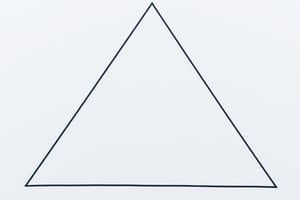Podcast
Questions and Answers
In a right-angled triangle, which side is opposite the right angle?
In a right-angled triangle, which side is opposite the right angle?
- Opposite side
- Hypotenuse (correct)
- Adjacent side
- Base
What is the sum of the squares of the lengths of the two shorter sides in a right-angled triangle?
What is the sum of the squares of the lengths of the two shorter sides in a right-angled triangle?
- $a^2 \times b^2$
- $a + b$
- $a^2 + b^2$ (correct)
- $a^2 - b^2$
Which type of triangle has all three interior angles measuring $60^ ext{o}$?
Which type of triangle has all three interior angles measuring $60^ ext{o}$?
- Obtuse triangle
- Equilateral triangle (correct)
- Isosceles triangle
- Scalene triangle
In an isosceles triangle, which property applies to the sides?
In an isosceles triangle, which property applies to the sides?
What is the formula for calculating the area of a triangle given its base and height?
What is the formula for calculating the area of a triangle given its base and height?
Which type of triangle has no equal side lengths?
Which type of triangle has no equal side lengths?
What distinguishes a scalene triangle from other types of triangles?
What distinguishes a scalene triangle from other types of triangles?
Which type of triangle has one interior angle measuring 90 degrees?
Which type of triangle has one interior angle measuring 90 degrees?
How is the area of a triangle calculated using Heron's formula?
How is the area of a triangle calculated using Heron's formula?
What does the Pythagorean theorem relate to in triangles?
What does the Pythagorean theorem relate to in triangles?
In a right-angled triangle, what does an interior angle measuring 90 degrees indicate?
In a right-angled triangle, what does an interior angle measuring 90 degrees indicate?
What property distinguishes an equilateral triangle from other types of triangles?
What property distinguishes an equilateral triangle from other types of triangles?
Flashcards are hidden until you start studying
Study Notes
Triangle Properties
In the world of geometry, triangles are fundamental shapes with fascinating properties that have been studied for centuries. Let's delve into three essential aspects of triangles: the Pythagorean theorem, various types, and calculating their area.
Pythagorean Theorem
Perhaps the most well-known and celebrated fact about triangles is the Pythagorean theorem, first recorded in the works of the Greek mathematician Pythagoras around 500 BCE. It states that in a right-angled triangle, the square of the length of the hypotenuse (the side opposite the right angle) is equal to the sum of the squares of the lengths of the other two sides.
Mathematically, this relationship is expressed as:
[ a^2 + b^2 = c^2 ]
where (a) and (b) are the lengths of the triangle's two shorter sides, and (c) is the length of the hypotenuse (the side opposite the right angle).
The Pythagorean theorem is not just a useful tool for solving problems involving right triangles but forms the basis for solving a wide range of problems in geometry and trigonometry.
Types of Triangles
Triangles come in various shapes, and each type has unique properties. Some of the essential triangle types include:
- Equilateral triangle - All three sides are equal in length, and all three interior angles measure (60^\circ).
- Isosceles triangle - Two sides are equal in length, and the interior angles opposite these sides are equal in measure.
- Scalene triangle - All three sides are of different lengths, and all three interior angles have different measures.
- Right-angled triangle - One interior angle measures (90^\circ), and the other two angles measure less than (90^\circ).
Each type of triangle has its own interesting properties and applications.
Area of a Triangle
Calculating the area of a triangle is a fundamental skill in geometry. There are two common methods for calculating the area of a triangle:
- Heron's formula - This method uses the lengths of the triangle's three sides (or semiperimeter) to find the area. Heron's formula states that:
[ A = \sqrt{s(s - a)(s - b)(s - c)} ]
where (A) is the area of the triangle, and (s) is the semiperimeter, equal to half the sum of the triangle's sides: (s = (a + b + c) / 2).
- Base times height method - This method uses the base and height of the triangle to find the area. The area can be calculated as:
[ A = \frac{1}{2}bh ]
Where (b) is the base and (h) is the height of the triangle.
Both methods are useful in different situations, and mathematicians continue to explore new ways to calculate triangle areas and their related properties.
Conclusion
The properties of triangles form the foundation of a wide range of geometric and mathematical concepts, and studying them can be both fun and educational. The Pythagorean theorem, types of triangles, and calculating their area are just a few of the fascinating aspects of this subject. Embrace the world of triangles, and you'll open the door to a wealth of exciting discoveries and applications.
Studying That Suits You
Use AI to generate personalized quizzes and flashcards to suit your learning preferences.




